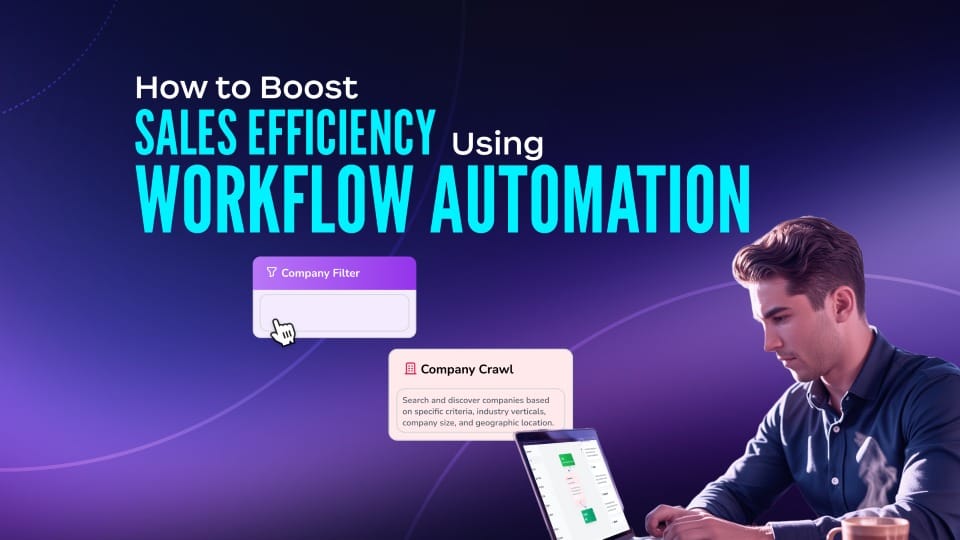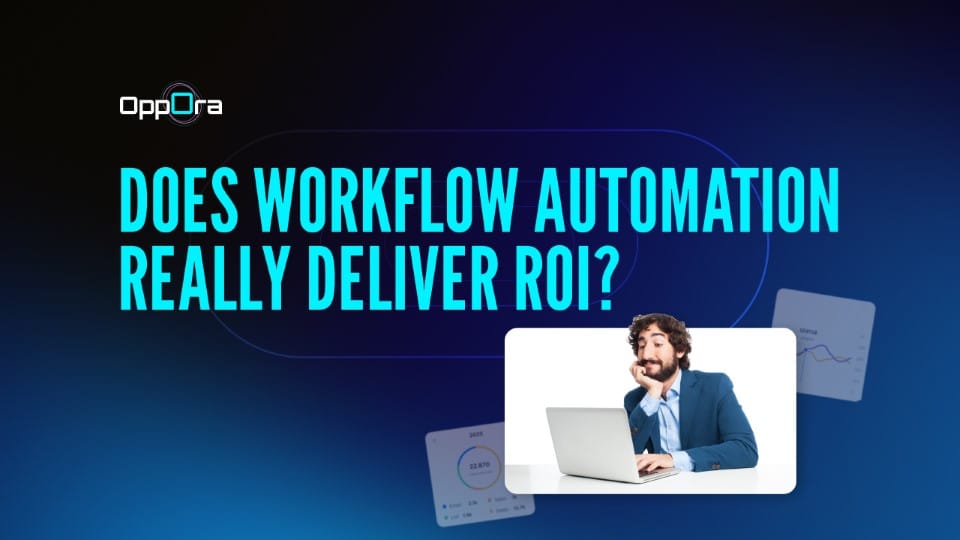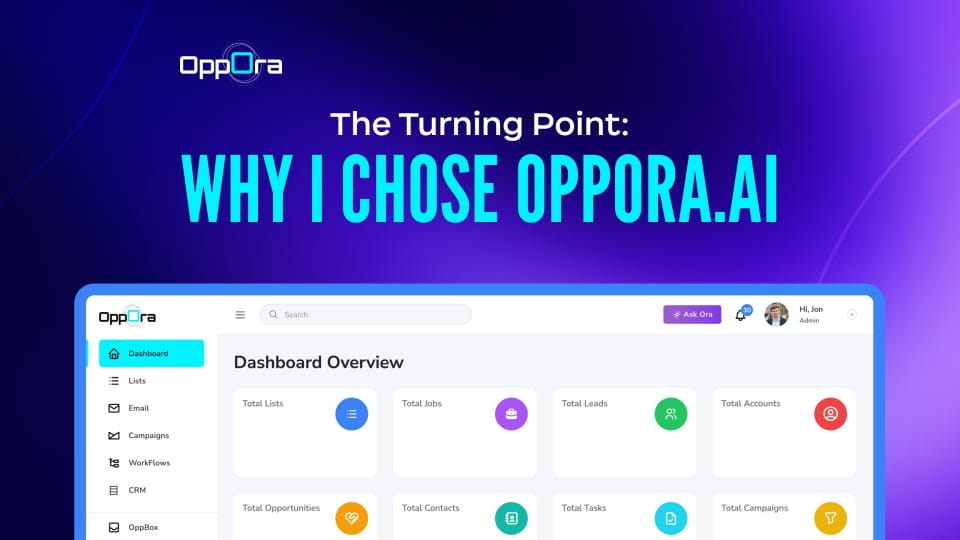How Workflow Automation Transforms Sales Efficiency and Frees Reps from Manual Tasks
sales workflow automation, sales automation, sales productivity, sales process, automated workflow, crm software, sales reps, customer data, sales funnel, sales engagement, marketing automation, customer experience

Every sales rep I’ve worked with has the same problem: too much time spent on manual work instead of closing deals. I know this pain myself. My mornings were filled with lead search, checking emails, and updating spreadsheets. By lunchtime, I hadn’t even talked to a single potential client.
The irony? We were hired to sell, not to be full-time admins. But like most sales people, we were stuck handling repetitive work and boring data entry. End of the day, we might have done dozen's of “tasks,” but the real sales process,building trust, finding opportunities, and closing deals,hardly moved forward.
"A McKinsey study confirmed what I saw every day: sales people spend 65% of their time on admin work and manual tasks instead of real selling【McKinsey, 2023】."
That means I was losing the most valuable resource of all-time.
I started asking myself: if we keep wasting time on manual work, how will we ever grow our sales funnel or serve customers well?
The Question That Changed Everything
One evening, staring at a half-updated CRM, I asked myself a simple question:
👉 “What if the hours my team wastes on repetitive manual tasks could be spent talking to customers, building relationships, and closing deals?”
That single thought shifted my perspective. The issue wasn’t the sales reps. It wasn’t the marketing team. It wasn’t even the number of leads we had. The problem was inefficiency in our sales workflow automation-or rather, the lack of it.
We were stuck in an outdated way of working, where every step in the sales pipeline-from lead capture to sales proposals-depended on human effort. No wonder things slipped through the cracks.
That’s when I discovered the real power of sales automation.
Visual Comparison: Sales Workflow Before vs. After
Chart: Sales Efficiency Metrics
Table: Oppora.ai Example - Sales Efficiency
The entire process changed. We weren’t just moving faster-we were moving smarter.

Does Workflow Automation Really Deliver ROI?
Now, you might be thinking: “Okay, this all sounds good. But does it actually pay off?”
I asked myself the same question before diving in. So I looked at the numbers:
- Workflow automation increases productivity by 30% on average【Kissflow, 2024】.
- Human errors drop by 40–75% with automated processes【Formstack, 2023】.
- Companies save around $46,000/year by automating sales and reporting workflows【Formstack, 2023】.
- 80% of businesses say automation lets them scale without hiring more headcount【Forrester, 2023】.
And here’s what happened when I implemented Oppora.ai internally:
- Lead response time dropped from 22 hours → under 3 hours.
- Sales cycle length shrank by 18%.
- Conversions from lead → opportunity improved by 27%.
For me, that was all the proof I needed: workflow automation isn’t just cost-saving, it’s revenue-generating.
What Sales Workflow Automation Really Means
Let’s get practical. Sales workflow automation isn’t just about using a fancy CRM or sending bulk emails. It’s about designing an automated workflow that removes friction from the entire process of selling.
Here’s how I define it:
- Triggers: A new lead signs up, downloads an ebook, or connects via LinkedIn.
- Rules: The system checks customer data like role, company size, and intent.
- Actions: Verified leads get scored, added to the CRM software, assigned to a sales rep, and automatically entered into a personalized outreach sequence.
Think about it: instead of a sales rep wasting time on manual work like updating fields, setting reminders, or typing the same follow-up email, an automated workflow can handle these tasks in seconds.
For me, the real magic was that it freed the team to focus on what they do best-talking to customers, sharing solutions, and building relationships.
That’s why I chose Oppora.ai. It’s not just another sales automation tool-it’s built to connect sales tasks, marketing campaigns, CRM data, and customer interactions in one smooth flow.

The Turning Point: Why I Chose Oppora.ai
At Oppora, I knew we couldn’t continue losing hours to manual lead search and fragmented systems. We needed a solution that could:
- Handle lead generation without draining valuable time.
- Sync seamlessly with existing CRM software.
- Empower reps to focus on sales activities instead of administrative tasks.
- Align with our marketing team for smoother collaboration.
I considered big platforms like HubSpot Marketing Hub and Salesforce Marketing Cloud. They’re powerful, no doubt. But they felt bloated-built for enterprises with thousands of employees. For a fast-growing sales team, they often required more maintenance than they saved.
That’s when I Use on Oppora.ai. What set it apart was the focus on AI sales automation built for modern sales reps:
- AI-driven lead scoring → Reps knew which opportunity mattered most.
- Automated campaigns → Outreach was consistent without burning reps out.
- Customer data enrichment → Every profile was complete, verified, and ready.
- Chrome Extension → Capture leads instantly with a single click.
- Ask Ora (AI Assistant) → Get instant, AI-powered sales insights and recommendations.
- Automated Workflows → Seamlessly connect prospecting, outreach, and CRM updates into one streamlined process.
- AI Personalization → Use dynamic variables and templates to create tailored messages at scale.
- Multi-Step Campaigns → Run coordinated campaigns across LinkedIn and email for maximum reach.
- AI Scoring → Prioritize only the hottest leads so sales reps focus where it matters most.
- Oppobox Unified Inbox → Manage every reply in one organized, centralized inbox.
Oppora turned our messy sales process into a clean, scalable automated workflow.Also, they provide step-by-step knowledge on how to use it, so even new users can get started quickly and confidently.
👉 All in all, it’s the complete solution for startups, SMBs, and busy sales teams who want to save time, boost productivity, and scale without tool overload.
Before vs. After: A Day in the Life of a Sales Rep
To appreciate the difference, let me walk you through a typical day.
Before Automation
- Morning: 2 hours wasted on manual lead search.
- Midday: Entering data into CRM software, fixing duplicates.
- Afternoon: Sending generic follow-ups manually.
- Evening: Building reports for managers.
Net result? Lots of “activity,” little progress. Maybe 2–3 conversations with a potential client.
After Automation with Oppora.ai
- Morning: Log in to a dashboard of scored, verified leads.
- Midday: Personalized campaigns already running automatically.
- Afternoon: Time spent on demos and customer interactions.
- Evening: Reports generated by the system-no manual work needed.
Now, instead of drowning in administrative tasks, reps spent their valuable time where it mattered: the sales funnel.
Sales Productivity Gains From Automated Workflows
One of the biggest wins was in sales productivity. Here’s why:
- Reps spent less time on repetitive tasks like verifying emails and updating records.
- Collaboration improved because marketing and sales worked from the same customer data.
- Sales pipeline visibility increased thanks to clean CRM updates.
- Sales activities like calls and demos doubled, because reps weren’t stuck doing manual work.
When I looked at the numbers, the productivity boost was undeniable." According to Salesforce, teams that adopt sales automation software see up to 53% higher conversion rates【Salesforce, 2023】."
For Oppora, that meant fewer lost opportunities and more deals closed.
Customer Data: The Secret Weapon
Here’s the truth: automation is useless without good customer data. That’s why Oppora.ai puts data enrichment at the core of every automated workflow.
We synced with CRM software, cleaned duplicates, and enriched profiles with verified contact info. Suddenly, customer interactions were more relevant because reps had full context.
- No more emailing the wrong decision-maker.
- No more missing details about company size or budget.
- No more wasting effort on fake leads.
Good data made every sales proposal, every marketing campaign, and every customer experience stronger.
Sales Engagement With AI Automation
Another breakthrough was in sales engagement. Using tools like LinkedIn Sales Navigator together with Oppora, we automated the way we reached out to potential clients.
Instead of sending generic blasts, each campaign was tailored using AI sales automation. Oppora generated personalized sequences that made reps feel human at scale.
The result? More replies, warmer conversations, and stronger relationships.
Smarter Marketing + Sales Collaboration
The old saying used to be “sales blames marketing for bad leads, marketing blames sales for not following up.” With automation, that blame game ended.
Oppora connected our marketing team’s campaigns with the sales pipeline. Leads from campaigns flowed directly into automated workflows. Customer interactions were tracked in one place.
That meant sales reps didn’t waste valuable time chasing cold leads. They worked on qualified opportunities already warmed up by b2b marketing automation.
Forecasting and the Bigger Picture
Finally, automation gave us something I didn’t expect: clarity in sales forecasting.
Because the entire process was automated, we had cleaner data and more consistent metrics. That made it easier to predict revenue, track opportunities in the sales funnel, and set realistic goals.
And this wasn’t just for managers-reps loved it too. They could see their pipeline, understand their performance, and plan their tasks without stress.
Lessons Learned about Workflow Automation
Here’s what I learned from Oppora’s automation journey:
- Clean data first → Bad customer data ruins workflows.
- Start with one task → Don’t automate everything at once.
- Measure impact → Track sales productivity gains, not just activities.
- Balance automation + human touch → Keep humans in key customer interactions.
- Iterate often → The sales process evolves; your workflows should too.
Risks and How I Handled Them
Yes, there are risks:
- Over-automation makes you sound robotic.
- Bad customer data creates bigger messes.
- Employees may resist at first.
But I learned to overcome them by:
- Keeping reps in control of final decisions.
- Using automation for repetitive tasks only.
- Showing the team the time savings they gained.
FAQ
Q1. What is the biggest advantage of sales workflow automation?
A: It saves valuable time by eliminating repetitive manual tasks, allowing sales reps to focus on customer interactions and closing deals.
Q2. Do small teams benefit from sales automation, or only large companies?
A: Even small teams gain huge value-automation reduces administrative tasks and boosts sales productivity without extra headcount.
Q3. Can workflow automation replace CRM software?
A: No, it works best alongside a CRM by automating updates, enriching customer data, and keeping the sales pipeline clean.
Q4. Does automation hurt the personal touch in customer experience?
A: Not if done right-automation handles the repetitive tasks so reps have more time for meaningful customer interactions.
Q5. Will automation reduce the need for sales reps?
A: No,It frees sales professionals from manual work so they can focus on building trust, nurturing opportunities, and closing more deals.
Q6. Do I need CRM software to start workflow automation?
A: Not always, but integrating with a CRM ensures customer data, activities, and pipelines stay clean and connected.
Q7. How does automation help the marketing team?
A: It aligns marketing and sales, ensuring campaigns feed directly into the sales pipeline with qualified, ready-to-convert leads.
Q8. How does sales workflow automation improve forecasting?
A: By keeping customer data accurate and consistent, automation makes sales forecasting more reliable and less guesswork-driven.
Q9. What risks should businesses watch out for when automating?
A: The main risks are over-automation, poor data quality, and resistance from employees, but these can be managed with the right strategy.
Q10. What’s the biggest long-term benefit of sales workflow automation?
A: It saves time, improves sales productivity, and creates a scalable sales process that grows with your business.
Conclusion: Turning Wasted Time Into Growth
When I look back, the shift is clear:
- From manual tasks to automated workflows.
- From wasted effort to focused sales activities.
- From administrative work to actual closing deals.
- From frustrated employees to motivated sales professionals.
That’s the real promise of sales workflow automation. It’s not about replacing reps-it’s about freeing them from repetitive tasks so they can do what they were meant to: build relationships, serve customers, and grow revenue.
And for us, the tool that made it happen was Oppora.ai.